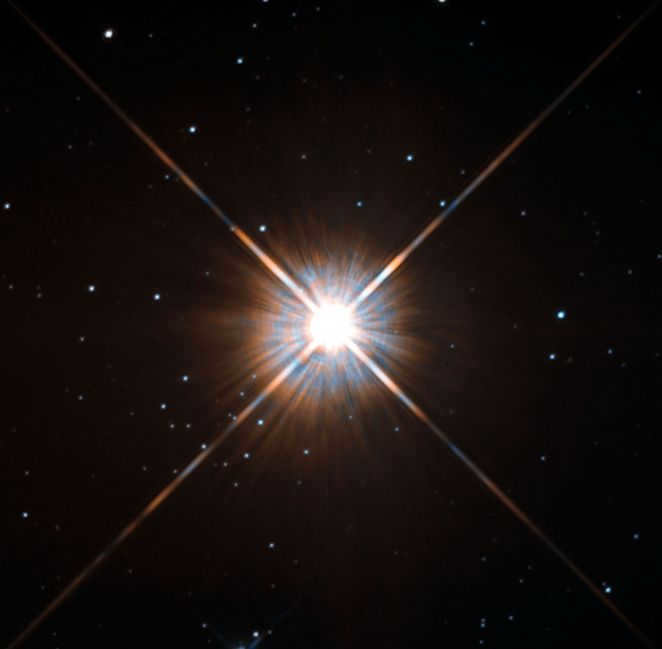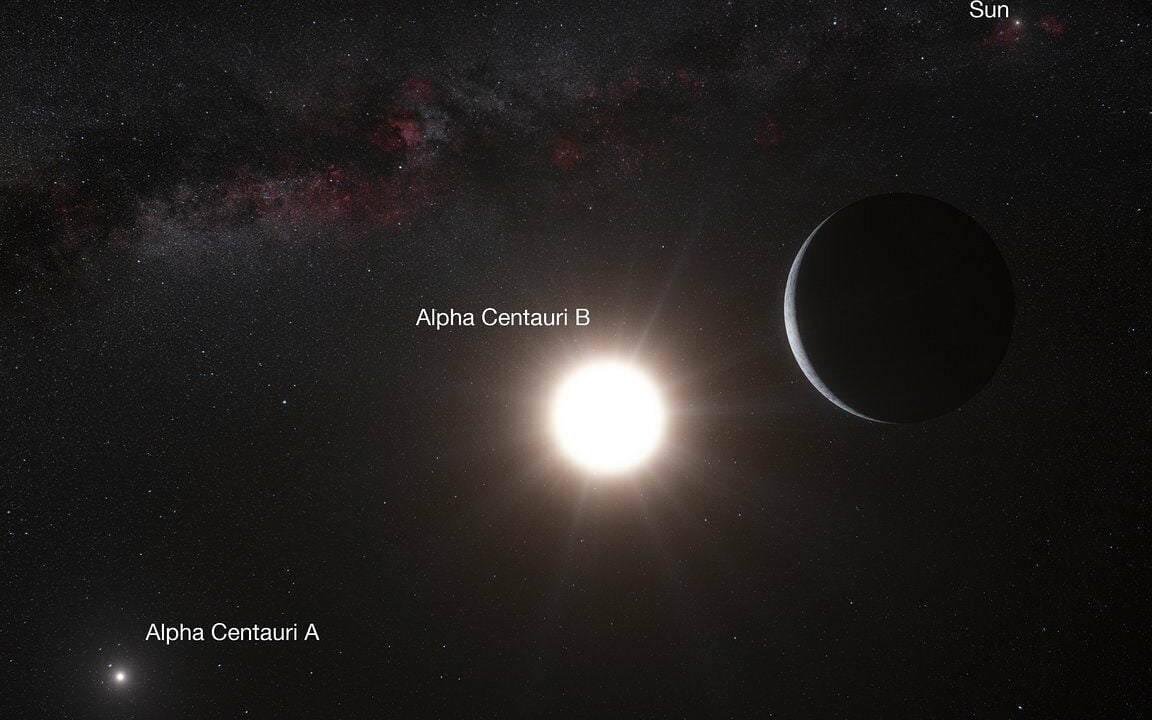It is more accurate to inquire about the closest star to the Sun, as the Earth orbits around it, but on a cosmic scale, this is not particularly significant.
So, what star is the nearest to the Sun?
For a long time, it was believed that Alpha Centauri, located in the southern hemisphere of the sky, was the closest star to the Sun. It is situated 4.37 light-years away. However, in 1915, a star called Proxima Centauri was discovered near Alpha Centauri, and it is likely part of the Alpha Centauri system.
Therefore, in general, we can conclude that the Alpha Centauri system is the closest star system to Earth, encompassing all of its components.
Continue reading for more information.
Nearest star to Earth
The biggest star in the Alpha Centauri system is known as Alpha Centauri A.
Close by is the second star, Alpha Centauri B, which is slightly smaller in size.
Both of these stars orbit around a shared center of mass, leading to their alternating positions as the nearest star to Earth.
However, there is another minuscule star called Proxima Centauri that revolves around this pair of Alpha Centauri stars.
The movements of these three stars in relation to each other are highly intricate.
And yet, at present, it is Proxima Centauri that holds the distinction of being the nearest star to Earth.
Proxima Centauri
Proxima Centauri is classified as a red dwarf star, and it has an apparent magnitude of only 11.05 m. Its absolute magnitude is even lower, at 15.49 m.
As a result, if we were located on Alpha Centauri, we would perceive Proxima Centauri as a faint star with a magnitude of approximately 5th.
The distance between the Sun and Proxima Centauri is approximately 4.22 light years.

It is theorized that Proxima Centauri revolves around the Alpha Centauri system over a span of approximately 500,000 years. Due to this, Proxima Centauri is occasionally referred to as Alpha Centauri C, making it the third component of the Alpha Centauri star system.
The distance of Proxima Centauri’s orbit around Alpha Centauri is roughly 15,000 ± 700 a.u. or about 0.21 light-years. In comparison, the distance from Proxima Centauri to the Sun is merely 20 times this measurement.
The confirmation of Proxima Centauri’s affiliation with the system is still considered inconclusive. However, the nearly identical vectors of motion between Proxima Centauri and the Alpha Centauri pair support this assumption. These same motion vectors are also present in other stars within the same system.
Using the Hubble telescope, scientists have extensively studied the space surrounding Proxima Centauri and have determined that there are no red dwarfs orbiting it. Additionally, there are no super-Earths, which are planets slightly larger than Earth, within the habitable zone.
Nevertheless, on August 24, 2016, the European Southern Observatory officially confirmed the existence of an exoplanet similar to Earth within the habitable zone of Proxima Centauri. This newly discovered planet has been named “Proxima Centauri b”.
The Nearest Stars to Earth in the Past and Future
Stars are in constant motion, although this movement is not noticeable within the span of a human lifetime. Has Proxima Centauri always been the closest star to the Sun, and how long will it remain so?
For the past 32,000 years, Proxima Centauri has held the title of the closest star to the Sun, and it will continue to hold this distinction for a considerable amount of time. However, in approximately 33,000 years, the closest star to the Sun will be Ross 248, a solitary star located in the Andromeda constellation. Currently, Ross 248 is situated at a distance of 10.3 light years from the Sun, which is 2.5 times farther than the current distance to Proxima Centauri.
Closest stars to Earth: A comprehensive list
Take a glance at our comprehensive list showcasing the closest stars to Earth, along with their key features and characteristics.
Following the table, you’ll find a spatial map illustrating the relative positions of these stars in relation to the Sun.

The arrangement of the closest stars to Earth in space:
We can create a diagram to depict the direction of the stars’ motion, indicating which stars will trail behind the Sun and which will catch up to it, as well as the vector pointing towards the center of the galaxy.
It’s an intriguing concept, but it poses challenges as the ready-made form for calculating the vector is not readily available, and it’s also complex to represent it on this particular projection.
Nikolai, September 11, 2021
What if we displace the Sun from the center and position it at a more current point?

The secrets concealed by the stars nearest to us will continue to captivate scientists, amateur stargazers, and writers of speculative fiction for numerous decades, if not centuries, to come.
The Sun, which serves as the foundation of our solar system, is the nearest star to Earth. It stands out from all other celestial bodies as it is clearly visible during the day. Once night falls, the vast cosmos reveals the rest of its luminous inhabitants. The sheer number of stars that populate the Universe is incalculable. However, scientists have managed to identify and compile a list of the nearest celestial bodies within a 16 light-year radius. This comprehensive list consists of 57 star systems, some of which are not single stars but rather double or triple star systems, bringing the total number of celestial bodies to 64. Additionally, the list also includes 13 brown dwarfs, which are significantly smaller in mass compared to other objects.
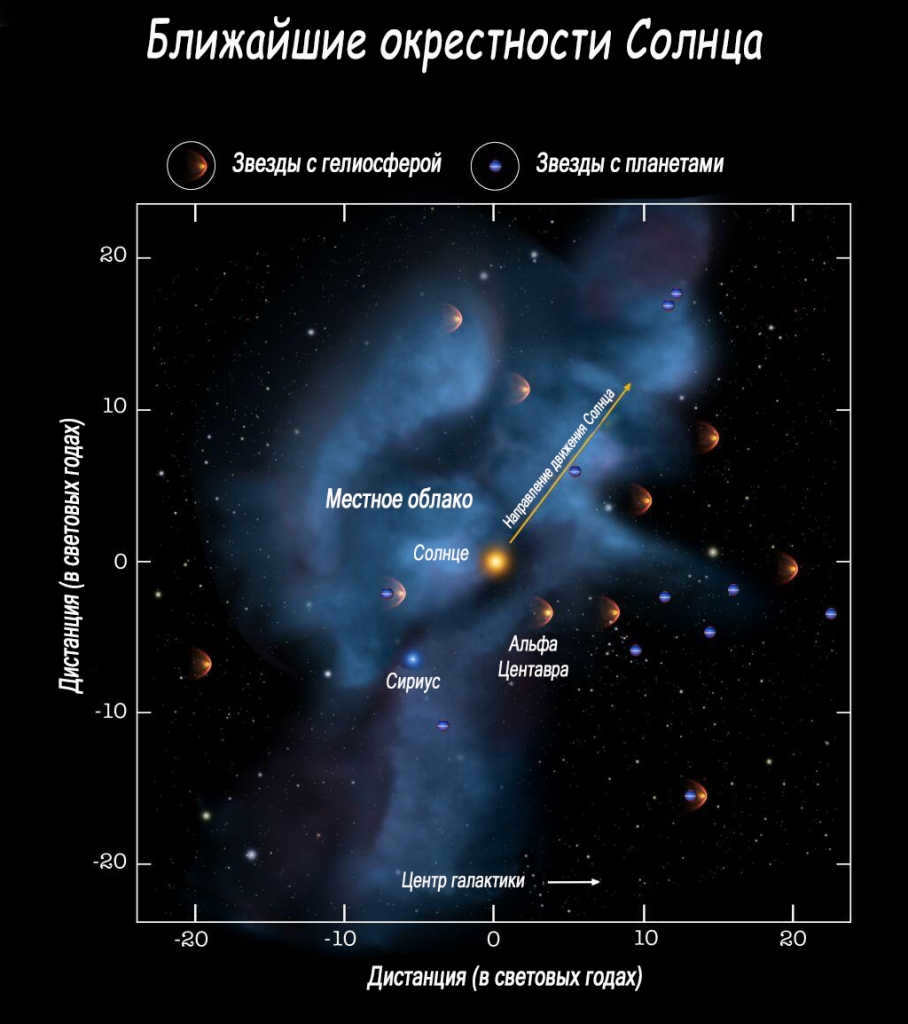
There are only 7 stars on the list that can be observed without the need for optical amplification. These stars are Sirius, Alpha Centauri, Epsilon Eridanus, Procyon, Epsilon Indian, Tau Kita, and 61 Swan. Their apparent magnitudes range from 1.43 to 6.03. Most of these stars belong to the red spectral class M, with temperatures ranging from 2600-3800 K. However, there are also two hot stars included in the list. Sirius A is a white star with a spectral class of A and a temperature of 9940 K, while Procyon A is a yellow-white star with a spectral class of F and a temperature of 6650 K. Additionally, the list includes brown dwarfs that belong to the spectral classes L, T, and Y. Finally, there are 4 white dwarfs of class D, which are considered rare objects in the visible sector of the Galaxy.
Distinctive Features of Alpha Centauri – the Nearest Star System to Our Planet
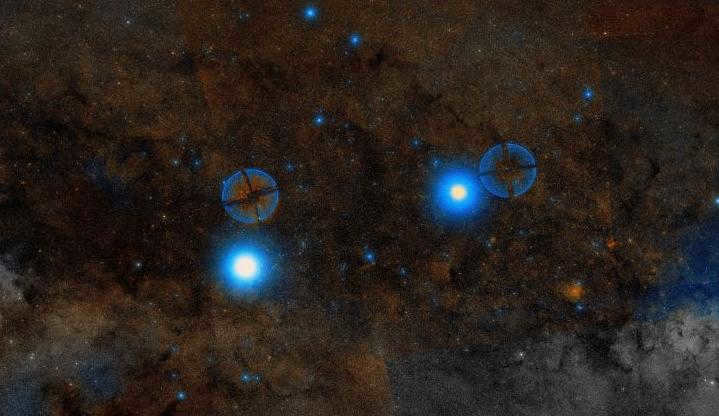
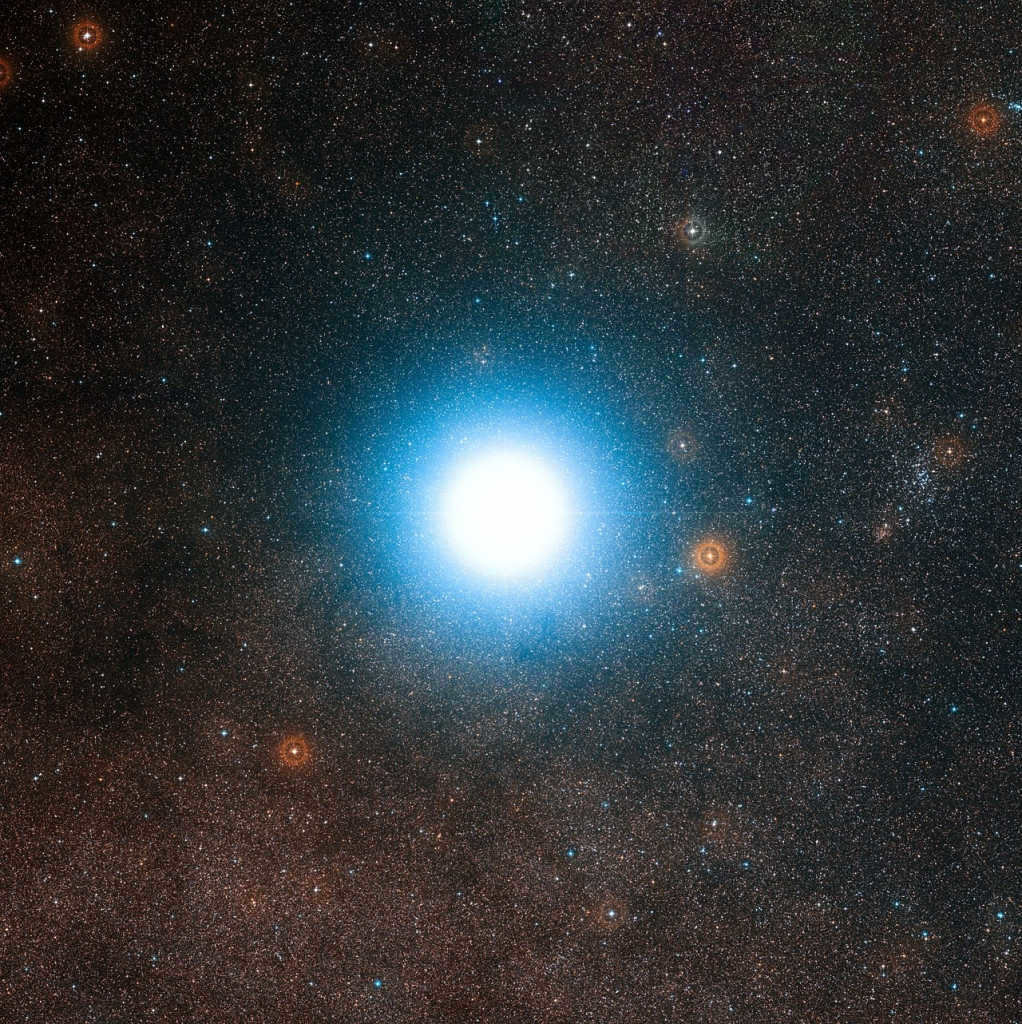
Alpha Centauri A and Alpha Centauri B, the other two components of the system, have a close interaction with each other. When observed from Earth, they appear as a single star. The system is located at a distance of 4.36 light years. Both objects belong to spectral classes G and K, making them yellow and orange dwarfs. They possess similar characteristics and temperatures to the Sun, although they are older, with an age of 6 billion years. Alpha Centauri A is larger than its neighboring star, with a mass of 1.1 and a diameter of 1.2 times that of the Sun. On the other hand, Alpha Centauri B has values of 0.9 and 0.86 for mass and diameter respectively. The luminaries rotate along an elliptical orbit, inclined at an angle of 79.2 degrees, and their period is 79.9 years.
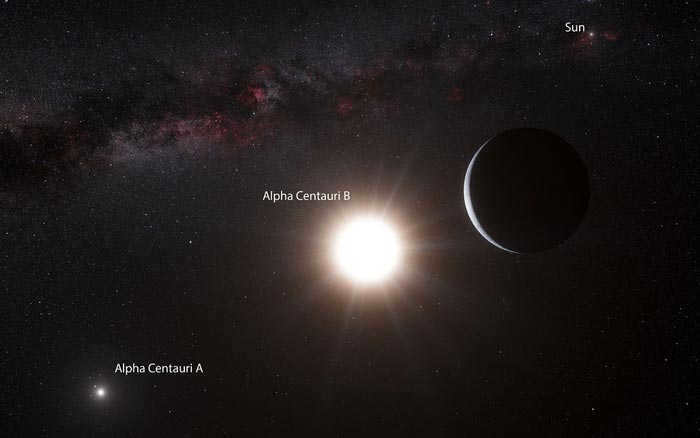
Additional research and computer simulation provide optimism for the existence of a second, larger, and more distant planet in the vicinity of Alpha Centauri B. This hypothetical planet has a rotation period of 20.4 days. According to theoretical calculations, it would experience the gravitational influence of Centauri A approximately once every 70 years. If this planet indeed possesses oceans, its barren surface would be significantly more susceptible to external forces.
Barnard’s Star
Barnard’s Star is a relatively close star to Earth, located in the constellation of Ophiuchus. It is a red dwarf star and is one of the nearest stars to our solar system, after the Alpha Centauri system and Proxima Centauri. Barnard’s Star was named after the American astronomer Edward Emerson Barnard, who discovered its proper motion in the early 20th century.
Barnard’s Star has a high proper motion, which means it appears to move relatively quickly across the sky. This is due to its close proximity to our solar system. It is estimated to be about 5.96 light-years away from Earth, making it the fourth closest known individual star to us.
Despite its proximity, Barnard’s Star is not visible to the naked eye. It has an apparent magnitude of about 9.5, which makes it too faint to be seen without the aid of a telescope. However, it is a popular target for amateur astronomers due to its relatively high proper motion.
Barnard’s Star is a relatively old star, estimated to be about 7 to 12 billion years old. It has a relatively low mass, about 16% of the mass of our Sun, and a surface temperature of about 3,134 Kelvin. It is believed to have a large amount of magnetic activity, which is common for red dwarf stars.
In recent years, there has been speculation about the possibility of planets orbiting Barnard’s Star. In 2018, scientists announced the discovery of a potentially rocky super-Earth around the star, named Barnard’s Star b. This planet has a minimum mass of about 3.2 times that of Earth and orbits its star at a distance of about 0.4 astronomical units, with an orbital period of about 233 days. However, further studies are needed to confirm the existence of this planet.
Overall, Barnard’s Star is a fascinating star due to its proximity to our solar system and its relatively high proper motion. It continues to be a subject of study for astronomers as they try to learn more about its properties and potential planetary systems.
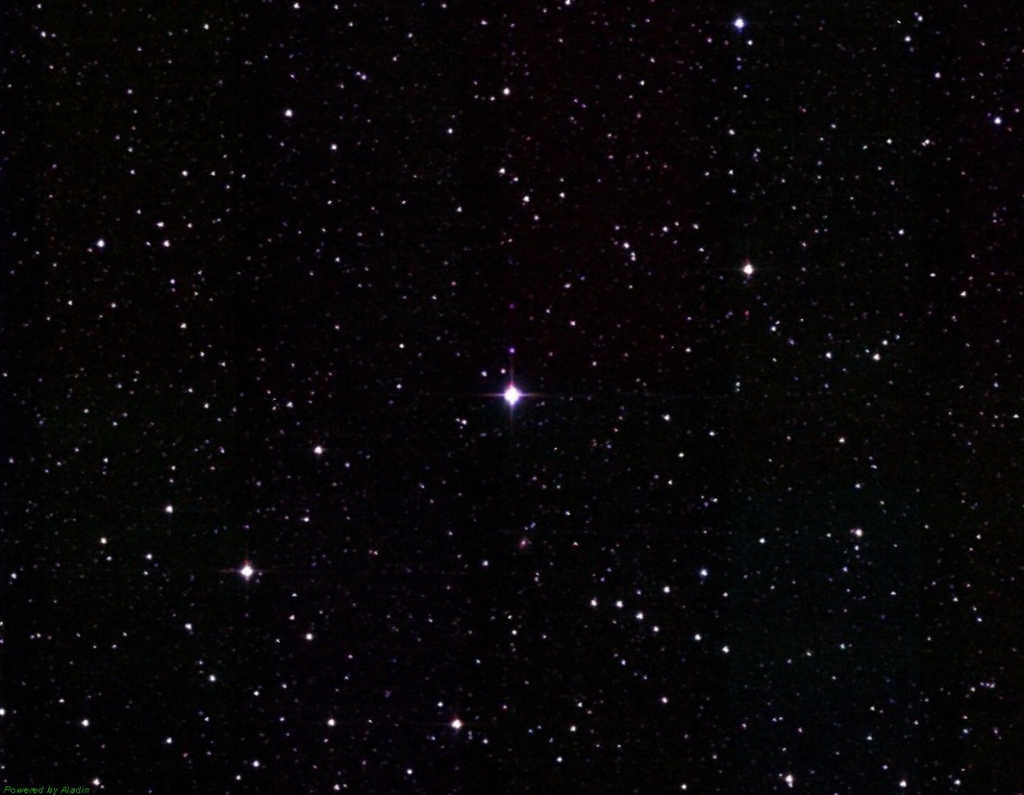

Planetary presence
A team of scientists from California has been dedicating their efforts for several decades to the search for planets orbiting Barnard’s star, however, up until now, there is no concrete evidence confirming their existence.
Luman 16 is a unique text rewriter tool that can help you paraphrase your text while maintaining its HTML markup intact.
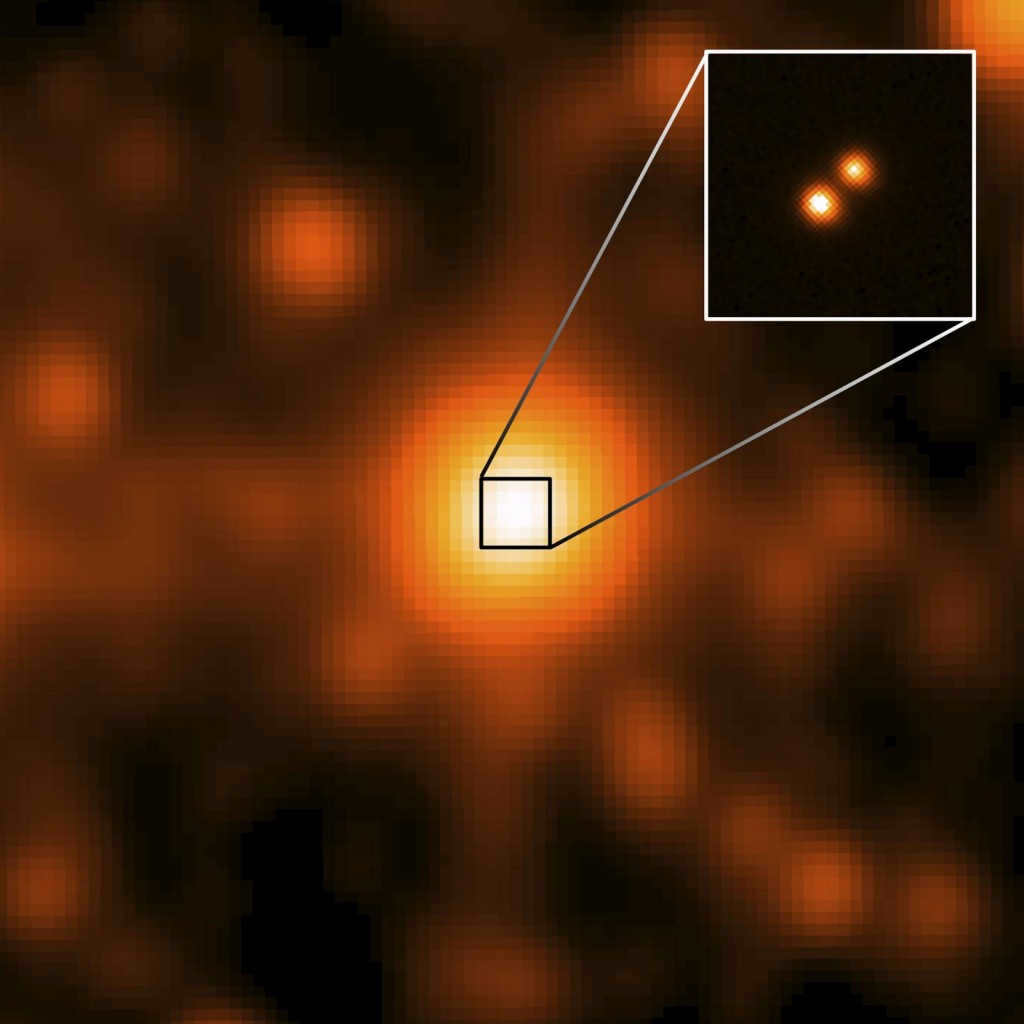
In the Southern Hemisphere lies the constellation known as Sails, which has recently become home to a unique double system of brown dwarfs. These brown dwarfs are the closest neighbors to our Sun, located at a distance of 6.59 light-years. Interestingly, the two components of this system are nearly identical in terms of mass, weighing in at approximately 0.4-0.5 times the mass of our Sun. Furthermore, these brown dwarfs have a remarkably slow rotation period, taking two decades to complete one full rotation. What’s even more intriguing is the fact that no other celestial bodies have been observed in the vicinity of this double star system.
An Earth spacecraft would require 70,000 years to reach our nearest neighbor, Proxima Centauri.
The separation between the two components of the binary star system, Alpha Centauri, is 22 angular seconds. They appear to merge to the naked eye, but can be distinguished with even the most basic telescope. The angular distance between Centauri A and B is not fixed. In 2010, it measured 6.74 angular seconds, and is projected to decrease to 4 by 2016. The maximum value will be observed in 2056.
Out of the stars in close proximity to us, only three are considered first magnitude luminaries: Sirius, Alpha Centauri, and Procyon. The closest star to Earth is a red dwarf.

The three stars in the Alpha Centauri system are the nearest stellar neighbors to the Sun. Alpha Centauri consists of two main stars, A and B, which form a binary system. The average distance from Earth to Alpha Centauri is approximately 4.3 light-years. The third star, Proxima Centauri (Alpha Centauri C), is the closest star to the Sun and is located 4.22 light-years away.
Alpha Centauri A and B orbit around a shared center of gravity every 80 years. The average distance between them is roughly 11 astronomical units (AU), which is similar to the distance between the Sun and Uranus. Proxima Centauri, on the other hand, is around 13,000 AU or one-fifth of a light-year away from the other two stars. This has led some astronomers to question whether it should be considered part of the same star system.
In a few million years, Proxima Centauri may travel through the system and move away from its current location. Alternatively, it could be gravitationally linked to a binary pair. If there is indeed a connection, Proxima’s orbital period around the other two stars in the system is estimated to be approximately 500,000 years.
A potentially habitable planet
In August 2016, astronomers made an announcement stating that they had made a discovery of an Earth-sized planet in orbit around Proxima Centauri. This newly found planet, called Proxima B, is believed to be around 1.3 times more massive than Earth. According to researchers, this indicates that Proxima B is a solid rocky planet.
The exoplanet is located within the star’s habitable zone, where the conditions are suitable for the existence of liquid water on its surface. Proxima B orbits its star at a distance of 7.5 million kilometers and completes one revolution every 11.2 Earth days. Consequently, it is highly probable that the exoplanet is tidally locked, meaning it always presents the same side to its star, similar to how the Moon only reveals one side to Earth.
Nonetheless, the habitability of Proxima B remains uncertain according to the available data gathered by current telescopes. In order to comprehend the potential habitability of this planet, astronomers must generate models and carry out comparative investigations. A more thorough examination of this world is necessary for scientists to search for indications of an atmosphere. If an atmosphere exists, it raises the question of whether it permits the presence of liquid water on the planet’s surface. The presence of an atmosphere also influences the surface temperature of the planet, which is crucial in evaluating Proxima B’s suitability for sustaining life.
Scientists are currently grappling with the challenges of modeling the properties of Proxima B, given its close proximity to its red dwarf star. The planet’s close proximity to the star suggests that it is tidally locked, meaning that one side of the planet is constantly facing the star, resulting in extreme temperature differences. As a result, one side of Proxima B is likely to be very warm, while the opposite side is expected to be very cold. The uneven distribution of heat across the planet could pose difficulties for the existence of life.
Another issue that arises from a planet’s proximity to a red dwarf is the presence of other challenges. Red dwarfs, being unstable stars, exhibit a significant amount of stellar activity during their youth, emitting charged particles that can lead to intense irradiation of neighboring planets. In a 2017 research conducted by NASA’s Goddard Space Flight Center, it was determined that a portion of this radiation has the potential to disintegrate molecules within a planet’s upper atmosphere, causing it to gradually become thinner over a period of time.
In order to gain a better understanding of Proxima B’s potential for supporting life, scientists are continuing their studies of red dwarf stars. In November 2017, another planet within the habitable zone of a red dwarf was discovered. This planet, known as Ross 128B, is located in proximity to Earth, similar to Proxima B. However, researchers believe that Ross 128B may offer a more peaceful environment compared to its neighboring planet. To further investigate the atmosphere of Ross 128B, the research team suggests using advanced telescopes such as the European Extremely Large Telescope (E-ELT), the Giant Magellan Telescope (GMT), and the Thirty Meter Telescope (TMT). These telescopes are anticipated to become operational in the 2020s. It should be noted that the James Webb Space Telescope (JWST) will not be able to conduct this type of analysis due to the planet’s trajectory not intersecting with the surface of its star.
Binary star
When observed with the naked eye, the two primary stars of this system appear to shine as a single entity, which makes them the third most luminous “star” in the night sky. However, when viewed through a small telescope, it becomes apparent that these stars are actually two separate entities. This binary star system is considered one of the most fascinating systems to observe. Unlike Proxima Centauri, which is too dim to be seen without assistance, these stars can be easily observed with the aid of a telescope. Furthermore, when viewed through a telescope, Proxima Centauri appears to be situated at a distance approximately equivalent to four times the diameter of a full moon away from the other two stars.
Throughout history, humans have cast their eyes skyward, marveling at the countless stars that dot the celestial expanse. These celestial bodies have captivated our imaginations, prompting us to ponder the mysteries of the universe. As time passed, our understanding of the cosmos grew, with knowledge being gathered and organized. It soon became clear that the stars were not mere specks of light, but rather colossal entities occupying vast regions of space. This revelation sparked a collective yearning among our early predecessors to venture forth and explore these distant worlds. However, before embarking on such a grand endeavor, they needed to determine the immense distances that separated them from these enigmatic stellar entities.
The distinction between a star and a planet
Here lies the fundamental contrast between the two:
- Size. A star typically possesses a significantly larger size compared to ordinary planets.
- Mass. A star boasts a considerably greater mass than a planet.
- Chemical composition. The former predominantly consists of light elements, while the latter comprises a mix of both light and heavy elements.
- Temperature. Planets tend to have much lower temperatures. This disparity accounts for the divergence in radiation spectra: planetary radiation primarily consists of infrared, while stellar radiation encompasses ultraviolet, X-rays, and gamma rays.
- Brightness and luminosity intensity. Stars emit light on their own, whereas planets merely reflect it.
- Chemical reactions occur in stellar bodies, where both thermonuclear and nuclear reactions take place. On the other hand, only nuclear reactions are possible in the center of planetary bodies, and these reactions are limited to that specific region.
- Planetary bodies exhibit motion in space as they orbit stars along an elliptical trajectory. Additionally, they have the potential to possess satellites. In contrast, stellar bodies do not rotate and lack satellites.
- The Sun, being a star, falls into the category of yellow stars. In terms of temperature, it is considered average for its type, not excessively high nor excessively low.

The Nearest Star to Earth
If we are discussing the boundaries of the solar system, it undoubtedly refers to the Sun. The Sun is a star and happens to be the closest one to us. It serves as the central point of our system. The existence of life on our planet and the formation of Earth are directly linked to this star. For this reason alone, it deserves our utmost attention.
The Sun has a diameter of 1,392,000 kilometers and can reach a scorching surface temperature of 1,500,000 degrees Celsius. The temperature gradually increases towards the center of the Sun. The Sun’s atmosphere is composed of three layers:
When discussing the closest star beyond our solar system, we refer to the diminutive Proxima Centauri.
The most brilliant celestial bodies beyond our solar system
Proxima Centauri
Although the distance of four parsecs may seem insignificant in the vastness of the universe, it is an immense distance for us humans. It would take more than a single generation to reach the outer reaches of Proxima Centauri.
Even the most discerning eye cannot spot it amidst the multitude of stars. It can only be observed in the night sky through the lens of a telescope. It emits a fainter light than our own Sun, approximately 150 times dimmer. Additionally, it is considerably smaller in size and has a surface temperature that is twice as low. Astronomers classify this celestial body as a brown dwarf and believe that the chances of discovering planets in its vicinity are highly unlikely. Therefore, embarking on a journey to Proxima Centauri would serve no purpose.
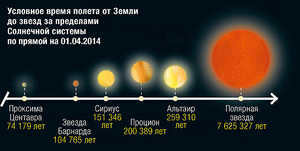
Alpha Centauri
This video will provide you with information on the distances between stars.
Exploring the Depths of Space
The Andromeda Nebula is currently the most distant object in the known Universe that can be seen without the need for specialized optical instruments. It shines with a brightness equivalent to approximately a quarter of a magnitude. According to astronomers’ calculations, the farthest star from Earth within this galaxy is situated at a staggering distance of 2 million light years. This magnitude is truly incomprehensible. It is mind-boggling to think that we are observing this star as it appeared 2 million years ago, providing us with a glimpse into the cosmic past!
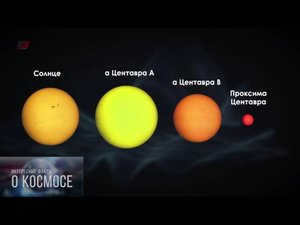
According to NASA’s findings, there are an additional 45 stars located 17 parsecs away from our Sun. The vast expanse of our galaxy holds an astonishing number of over 200 billion stars. However, it’s important to note that some of these stars emit such faint light that they are virtually undetectable without the aid of advanced equipment. With the continuous advancements in technology, it is highly probable that scientists will uncover stars that are even closer to our own solar system.
Video
This video will provide you with fascinating facts about the Sun.
If you enjoy our content, please consider giving us a thumbs up. It means a lot to our writers. Don’t forget to subscribe to our channel on Yandex.Zen and join our Vkontakte group.
© Dr. David Whitehouse, an astronomer and science correspondent for the BBC World Information Service, provides us with fascinating insights into the stars that are closest to us.
Closest Neighbors.
In order to determine the rightful position of our Sun among the vast array of stars, let us begin by examining its neighboring celestial bodies. The nearest neighbor of our Sun happens to be a complex system consisting of three stars that orbit around each other. Among these stars, the most luminous one is known as Alpha Centauri A., which bears a striking resemblance to our own yellow Sun. On the other hand, Alpha Centauri B is slightly smaller in size and its emitted light possesses a noticeable orange hue, attributable to its cooler surface temperature of approximately 4800 °C. In contrast, the Sun’s temperature reaches a higher value of 5800 °C. It is worth noting that stars with cooler temperatures tend to appear red, while those with higher temperatures exhibit shades of orange, yellow, and even bluish-white.
Barnard’s Star
Our nearby celestial neighbor is also known as Barnard’s star, which was named after Edward Emerson Barnard, a renowned astronomer from a century ago. This unassuming little star is situated towards the constellation of Serpens. It is the closest star that can be observed from the northern hemisphere using telescopes, although only a select few astronomers are currently conducting such studies. Barnard’s star bears a striking resemblance to Proxima Centauri and is classified as a red dwarf, the most prevalent type of star in our galaxy.
The weight of red dwarfs accounts for approximately 10-30% of the mass of our Sun. They possess nuclear reactions that are comparatively slow, resulting in a lifespan of 10 billion years. These stars are of great interest to scientists as studying them aids in the comprehension of our own Sun. While the outer layer of our Sun is a region of convective energy transfer, red dwarfs possess more powerful and deeper convective zones. In fact, certain red dwarfs can be entirely convective. This phenomenon leads to the creation of robust magnetic fields. When these fields emerge above the red surface of the stars, it can give rise to massive explosions.
Dwarf stars emit starbursts that are significantly more energetic than those produced by our Sun. These celestial bodies were initially discovered due to their brief, intense flares, earning them the nickname “flare stars.” Additionally, these remarkable starbursts have been found to emit radio waves. The first observation of this phenomenon was made by Professor Bernand Lovell of Manchester University in 1959. Subsequently, a new large telescope was installed at the Jodrell Bank Observatory to further investigate these events. Years ago, as a young graduate student (myself included), I spent numerous sleepless nights studying the controls of this radio telescope to develop innovative techniques for identifying stars. The findings from this research are now housed in the library at Jodrell Bank.
One of the celestial bodies we researched was hesitant to disclose its mysteries. One year, there was an abundance of flares to observe, while the following year, they became almost non-existent. I distinctly recall jotting down in my journal, “Could the behavior of this star resemble the 11-year cycle of the Sun?” Perhaps.
Barnard’s star is constantly in motion as it travels through the vast expanse of outer space. Its movement across the night sky is incredibly swift, making it the fastest-moving star of all. However, despite its rapid pace, the small size of Barnard’s star doesn’t significantly alter the shape and formation of the constellations. From the perspective of an observer on Earth, the constellations appear to be unchanging throughout their lifetime. Nevertheless, over long periods of time, the positions of stars gradually shift and evolve within the cosmic realm. For instance, our own Sun and the planets within our solar system take approximately 200 million years to complete an orbit around the center of the galaxy. This gradual process occurs so slowly that constellations that existed 10,000 years ago are still easily recognizable today. However, if a contemporary astronomer were somehow transported back in time one million years, the night sky would appear bewilderingly different. The motion of Barnard’s star across the sky is measured as half a degree every 175 years. It is currently moving closer to Earth and is projected to come into close proximity in the year 11800, a mere four light-years away. This would place it even closer to us than Proxima Centauri, one of the nearest stars to our own solar system.
Other neighboring stars
There exists another red dwarf in close proximity to our solar system that has gained fame through the television series Star Trek. This star is known as Wolf 359, and it has been the setting for a remarkable battle between the United Federation of Planets and the Borg, a highly advanced collective of cyborgs controlled by a central intelligence, who grow their numbers by assimilating entire worlds. Wolf 359 is situated in the Leo constellation and is the faintest star among its neighboring celestial bodies, making it one of the dimmest stars that humanity has discovered thus far. If Wolf 359 were to replace the Sun, Earth would either experience perpetual darkness or have illumination only 10 times brighter than moonlight.
There are numerous red dwarfs in close proximity to Earth. One example is Laland 21,185 located in the constellation of the Big Dipper. It is also worth noting UV Kita, which is a binary system consisting of two red dwarfs and serves as the prototype for the entire class of flaring stars that includes Proxima Centauri and Wolf 359. The distance between the stars in the UV Kita pair is six times the distance from the Earth to the Sun, and they have an orbital period of 25 years. Together, their combined mass is only 30% of the Sun’s mass.
Sirius, also known as the Dog Star, is the brightest star in the vicinity of the Sun. It belongs to the Big Dog constellation. In 1862, astronomers made the remarkable discovery that Sirius is actually a binary star system. The primary star, known as Sirius A, is a bluish-white star that is twice the size of our Sun and has a scorching surface temperature of 10,000 °C. Orbiting around Sirius A is its smaller companion, Sirius B, which is a white dwarf star. This white dwarf is of particular interest because it is the closest example of its kind to Earth. Despite being the same size as our planet Earth, Sirius B has the mass of the Sun, making it incredibly dense. In fact, a cup filled with matter from Sirius B would weigh as much as a jetliner. If you were to stand on its surface, you would experience a weight 100 times greater than what you would feel on Earth. These two distinct stars orbit each other at intervals of 50 years, with an average distance between them that is 20 times greater than their size. Lastly, we have Ross 154, the most recent star discovered within 10 light years of our planet. This red dwarf star adds to the diversity of celestial bodies in our cosmic neighborhood.
Where are we headed?
In 1783, William Herschel published his observations that led to the discovery of the motion of our solar system. He concluded that our solar system was moving towards a star called Lambda Hercules, also known as Maasim, which means “wrist” in Arabic. Herschel used the term “apex” (derived from the Latin word “arech” meaning top) to describe this direction, which refers to a point in the celestial sphere towards which astronomical objects move. The brightest star in the sky, Sirius, is an apex, representing the direction from which the Sun is moving.
The Sun moves in a specific direction as it orbits around the center of the Milky Way. All of the 100,000 stars in our galaxy also orbit around this center. The speed at which a star moves depends on its proximity to the center of the galaxy. In the case of our Sun, it is located 24,000 light years from the center and orbits at a speed of 220 km/s. It takes approximately 230 million years for the Sun to complete one full revolution around the galaxy. Over its lifespan, the Sun has traveled around the Milky Way about 18 times, although some data suggest it may be closer to 25-30 times.
In addition to its circular motion, the Sun also experiences oscillatory movements up and down relative to the galaxy’s plane. This oscillation occurs over a period of 70 million years, meaning that we pass through the galaxy’s median plane approximately every 35 million years. Some scientists have compared this period to the intervals between mass extinctions on Earth. Interestingly, the amount of cosmic rays reaching Earth has been increasing over the past 100,000 years as the Earth approaches the median plane of the galaxy. It is possible that this fact could have an impact on cloud cover and, in turn, Earth’s climate.
It is comprised of a variety of spiral branches, and our Sun is presently positioned within a minor spiral branch known as Orion, which links the larger spiral arms of Sagittarius and Perseus. Every 100 million years, Earth traverses the primary spiral arm, with the journey lasting for 10 million years. While passing through the spiral arm, the impact of the nearest supernova star intensifies, and its powerful radiation, emitted from distances of tens of light years, has the potential to alter Earth’s climate.
You have deactivated JavaScript. Please enable scripts in your browser to fully utilize the site’s functionality!
Throughout history, humans have looked up at the sky and observed countless stars. These stars have captivated them and sparked thoughts about the cosmos and the world around them. As time passed, knowledge about stars accumulated and became organized. It became evident that stars were not just points of light, but massive celestial objects. This realization fueled a desire in our ancestors to journey to these distant stars. However, they needed to determine the distance to these stars first.
Here is the fundamental distinction between stars and planets:
- Size. Stars are generally much larger in size compared to ordinary planets.
- Mass. Stars have a significantly greater mass than planets.
- The chemical composition varies between planets and stars. Planets are composed mostly of light elements, while stars contain both light and heavy elements.
- The temperature of planets is significantly lower than that of stars. This difference in temperature is reflected in their radiation spectra, with planets emitting mainly infrared radiation and stars emitting ultraviolet, X-rays, and gamma rays.
- Stars emit light themselves, while planets only reflect it.
- Chemical reactions in stellar bodies involve thermonuclear and nuclear reactions throughout their entire volume. In contrast, planetary bodies only undergo nuclear reactions, and these reactions only occur in the center of the nucleus.
- Planetary bodies move in elliptical trajectories around stars and may have satellites. Stars, on the other hand, do not rotate and do not have satellites.
- The Sun is a type of star known as a yellow star. It has an average temperature, not too high or too low.
The nearest star to Earth
If we are discussing stars within our solar system, the closest one is undoubtedly the Sun. It is a star and happens to be the nearest to us. It is also the central body of our solar system. Life on our planet would be impossible without it, and the Earth was formed in conjunction with this star. Therefore, it is worth examining closely.
Similar to other celestial bodies, the Sun primarily consists of hydrogen and helium, with the former being cyclically converted into the latter. Through thermonuclear reactions, heavier elements are synthesized. Consequently, as stars age, they accumulate more of these elements. Our Sun is already considered old, approximately 5 billion years old. The mass of the closest star to us equates to an astounding 595,800,000,000,000,000,000,000,000,000,000,000,000 Earth tons (for convenience, it is often recorded in alternative units, but this figure is evidently the most notable).
The Sun has a diameter of 1,392,000 kilometers. Its surface temperature can reach up to 1,500,000 degrees Celsius. This temperature increases towards the center. The Sun’s atmosphere consists of three distinct layers:
If we consider the nearest star outside of our solar system, it would be the diminutive Proxima Centauri.
Proxima Centauri
It is part of a triple system that is approximately four light-years away from us. In scientific terms, a light-year is referred to as a parsec. The star’s name itself, when translated from Latin, means “nearest,” which clearly indicates that the ancient people recognized its unique characteristics and its close proximity to us.
Although four parsecs may seem like a small distance within the vastness of the Universe, it is actually quite far for humans. It would take multiple generations to reach the boundaries of Proxima Centauri.
Among the stars, it is impossible to detect with the naked eye. The only way to observe it in the sky is by using a telescope. It emits a fainter light than the Sun, approximately 150 times dimmer. Additionally, it is smaller in size and has a surface temperature that is twice as low. Astronomers classify this celestial object as a brown dwarf and consider the likelihood of finding planets near it to be very low. Therefore, there is no incentive to embark on a journey towards it.
Alpha Centauri
The triple system of Alpha Centauri is also relatively close to us and deserves our attention – such objects are not very typical in the vastness of the Universe. They possess a certain allure due to the intricate orbits in which the stars revolve around each other, and occasionally even engage in the phenomenon of “devouring” their neighboring stars.
This video will provide you with insights into the distances to these stars.
Exploring the depths of the cosmos
The Andromeda Nebula holds the title for being the furthest object in the known Universe that can be observed without the aid of specialized optical instruments. Its luminosity is equivalent to approximately a quarter magnitude. According to astronomers, the most remote star within this galaxy is situated at a staggering distance of 2 million light years from Earth. This magnitude is truly mind-boggling, as we are witnessing the star as it appeared 2 million years ago – illustrating just how effortlessly we can peer into the cosmic history.
Based on information from NASA, there are an additional 45 stars located 17 parsecs from our Sun. The total number of stars in the universe is estimated to be over 200 billion, with some being so faint that they are nearly undetectable without specialized equipment. It is possible that with advancements in technology, researchers may discover stars that are even closer to our solar system.
Video
Gain fascinating knowledge about the Sun by watching this video.
If you still have unanswered questions, feel free to suggest a topic to the authors.
Stars may appear both distant and near. We perceive them as “tiny specks” (as eloquently described by a renowned poet), but in reality, they are massive – and so is the distance between them and us. There are various ways to measure this vast distance, and among them is the most remote star, as well as the closest one to Earth.
Naturally, many individuals would immediately think of the Sun. And they would be correct. However, this article will discuss a star known as Proxima Centauri. It was first observed in 1915 by an astronomer from England. Prior to its discovery, it was believed that Alpha Centauri was the nearest star to us. Although physically connected, these stars are indeed separate entities.
The red dwarf, which is the nearest star to Earth, is characterized by its small size and low temperature. As time passes, these stars gradually reduce in size and increase in temperature. Eventually, they transform into white dwarfs. In the distant future, Proxima Centauri will experience a similar destiny.
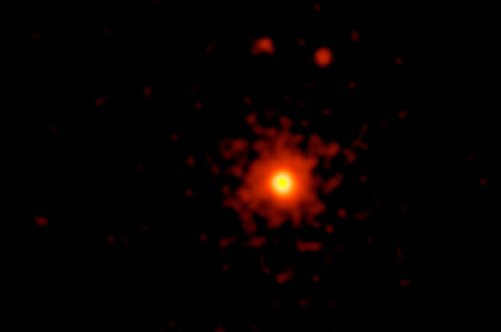
Furthermore, Proxima Centauri is a star that experiences periodic flares. During the latter half of the 20th century, it was even regarded as the most active in this aspect.
However, this particular star is relatively faint, making it impossible to observe without the assistance of a telescope. Additionally, it is worth noting that Proxima Centauri is not visible from the northern hemisphere. Its visibility begins at a latitude of 27 degrees north.
The distance from planet Earth to this aforementioned star is approximately 4.2 light years. Interestingly, the star that is closest to Earth has a size that is roughly 7 times smaller than that of the Sun.

Proxima Centauri is a component of a binary star system, which also encompasses the renowned Alpha Centauri. The latter, incidentally, has long held the distinction of being the nearest star to our planet.
Among the various designations of “the most,” it is noteworthy to mention the existence of the largest star, VY, located in the Canis Major constellation. This constellation contains a dwarf elliptical cluster, which happens to be the nearest galaxy to the Milky Way. It partially overlaps with our galaxy. Canis Major also includes Sirius, widely regarded as the most luminous star. Furthermore, it can be classified as one of the stars closest to Earth (including Proxima Centauri).
While most people can identify the star closest to Earth, not everyone is acquainted with supplementary details about it.
This celestial body is classified as a yellow dwarf, and it came into existence approximately 5 billion years ago. The radiant energy emitted by this star takes a mere 8 minutes to travel from its immense distance of around 150 million kilometers (known as 1 astronomical unit) to reach the Earth. Positioned at the heart of all planetary systems, it governs the movements of 8 planets along with their satellites, as well as a multitude of comets and meteorites that orbit around it.
The mass of this stellar entity surpasses that of our planet by a staggering 330 thousand times, while its size is a whopping 109 times larger! To truly grasp the enormity of this comparison, one can refer to the video below, which vividly showcases the relative scale of the planets in relation to the Sun.
The Sun is the most luminous entity in the whole sky of the Earth. The generation of energy by the sun is what caused life to emerge on Earth. It is fascinating to note that it is primarily composed of 90% hydrogen and 10% helium. Naturally, there are other elements present as well, but their proportion is merely 0.1%
Initial investigation
In the past, there was a belief among people that the Sun was stationary. However, this notion was disproven by Galileo Galilei in 1610 when he observed the movement of spots on its surface through his telescope. This observation led to the conclusion that the Sun is indeed rotating. Interestingly, its rotation is not uniform throughout: near the equator, it takes around 25 days to complete one rotation, while near the poles, it takes approximately 30 days. Moving at a speed of about 200 to 220 kilometers per second, it would take the Sun approximately 200 million years to complete a full revolution around the center of our galaxy.
The Sun releases an enormous amount of energy, specifically 6.5 kW per square centimeter of its surface. What’s fascinating is that this energy remains constant throughout the Sun’s lifespan. It’s worth noting that only a tiny fraction of this energy, one billionth to be precise, is necessary for supporting life on Earth. If the amount of energy reaching our planet were to fluctuate significantly, it would likely lead to the extinction of life on Earth.
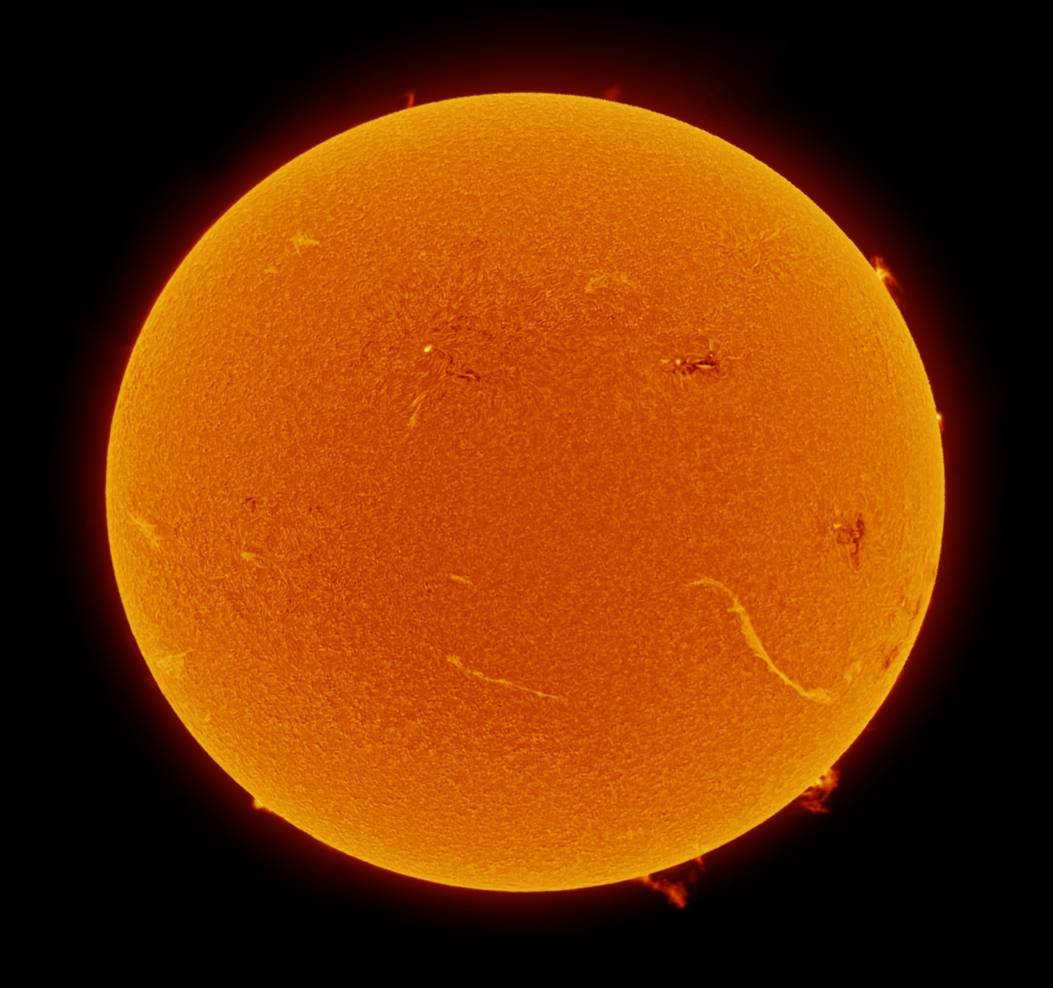
Throughout history, humanity has always been fascinated by the night sky, with its countless stars twinkling above. These celestial bodies have sparked wonder and curiosity, leading to the accumulation and organization of knowledge about them. As our understanding deepened, it became evident that stars are not mere specks of light, but rather vast objects in space. This revelation ignited a dream within humans — the desire to journey to the stars. However, before embarking on such a monumental journey, it was crucial to ascertain the distances that separated us from these cosmic wonders.
By utilizing telescopes and mathematical equations, scientists have been able to determine the distance to our cosmic neighbors (excluding objects within our solar system). So, which star resides closest to Earth? The answer is Proxima Centauri, a diminutive star. It is a component of a triple system and can be found just over four light years away from our Solar System (it’s worth mentioning that astronomers more commonly utilize parsecs as a unit of measurement). Its name, Proxima, is derived from the Latin word for “nearest.” While this distance may appear insignificant in the grand scheme of the Universe, with current advancements in spacecraft technology, it would require more than a single generation to traverse.
Proxima Centauri
This tiny star can only be observed in the sky through a telescope. It emits a much dimmer light compared to the Sun, approximately one hundred and fifty times fainter. It is also significantly smaller in size and its surface temperature is twice as low. Astronomers classify this star as a brown dwarf, and it is unlikely that any planets exist around it. Therefore, there is no reason to venture there. However, the Alpha Centauri triple system itself is already fascinating – such celestial objects are quite rare in the Universe. The stars within these systems orbit each other in peculiar paths, sometimes even “swallowing” their neighboring stars.
There are fifty-one star systems relatively close to the Sun. However, we will only mention eight of them. So, let’s get acquainted:
- The previously mentioned Proxima Centauri. It is located four light-years away and belongs to class M5.5 (red or brown dwarf).
- The stars Alpha Centauri A and B. They are 4.3 light-years away. Alpha Centauri A is a D2 class object, while Alpha Centauri B is a K1 class object. Alpha Centauri is also the closest star to Earth and has a similar temperature to our Sun.
- Barnard’s Star – It is also known as the “Flying Star” because of its high speed compared to other cosmic objects. It is located 6 light-years away from the Sun and belongs to class M3.8. In the sky, it can be found in the constellation Serpentine.
- Wolf 359 – located 7.7 light-years away. It is a 16th magnitude object in the Dragon constellation and belongs to class M5.8.
- The star Laland 1185 is situated 8.2 light-years away from our solar system. It can be found in the constellation of Ursa Major, also known as the Big Dipper. This celestial object belongs to the M2.1 class and has a stellar magnitude of 10.
- Tau Kita is positioned at a distance of 8.4 light years from our planet. It is classified as an M5.6 star.
- The Sirius A and B system is located at a distance of eight and a half light years from us. Both stars are categorized as A1 and DA.
- Ross 154 can be found in the Sagittarius constellation and is situated 9.4 light-years away from the Sun. This celestial body is classified as an M 3.6 star.
This list only includes cosmic objects that are within a distance of ten light years from our solar system.


Our solar system revolves around the Sun, which is the closest star to Earth. It stands out from other celestial objects because we can clearly see it during the day. However, during the night, we have the opportunity to observe various other stars scattered throughout the vast cosmos. The exact number of stars in the Universe is impossible to determine, but scientists have managed to identify and compile a list of the nearest celestial bodies within a 16-light-year radius. This list consists of 57 star systems, some of which are not single stars but rather double or triple star systems, bringing the total number of celestial bodies to 64. Additionally, the list includes 13 brown dwarfs, which are significantly less massive compared to other objects in the Universe.
Out of the list, there are only 7 stars that we can identify without the need for optical amplification. These stars are Alpha Centauri, Epsilon Eridanus, Epsilon Indian, Tau Kita, and 61 Swan. Their apparent magnitudes range between 1.43 and 6.03. The majority of these stars belong to the M spectral class, which is characterized by a red color. Their temperatures range from 2600-3800 K. On the other hand, there are two hot stars in the list: Sirius A, which belongs to the A spectral class and has a white color with a temperature of 9940 K, and Procyon A, which belongs to the F spectral class and has a yellow-white color with a temperature of 6650 K. Additionally, the list includes brown dwarfs that belong to the L, T, and Y spectral classes. Lastly, there are 4 white dwarfs of class D, which are quite rare objects in the visible sector of the Galaxy.
Distinctive Features of Alpha Centauri, Earth’s Nearest Star System
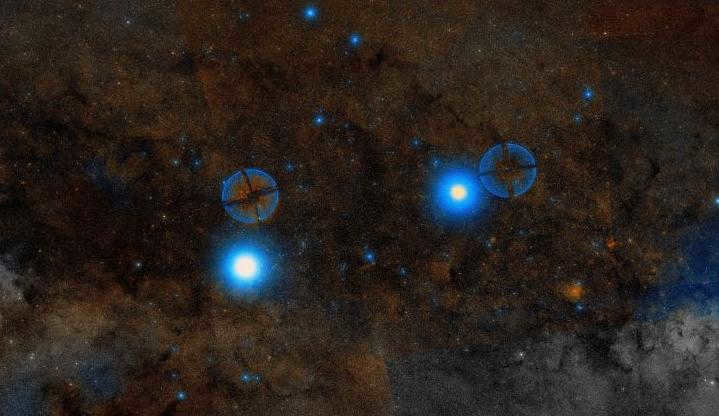
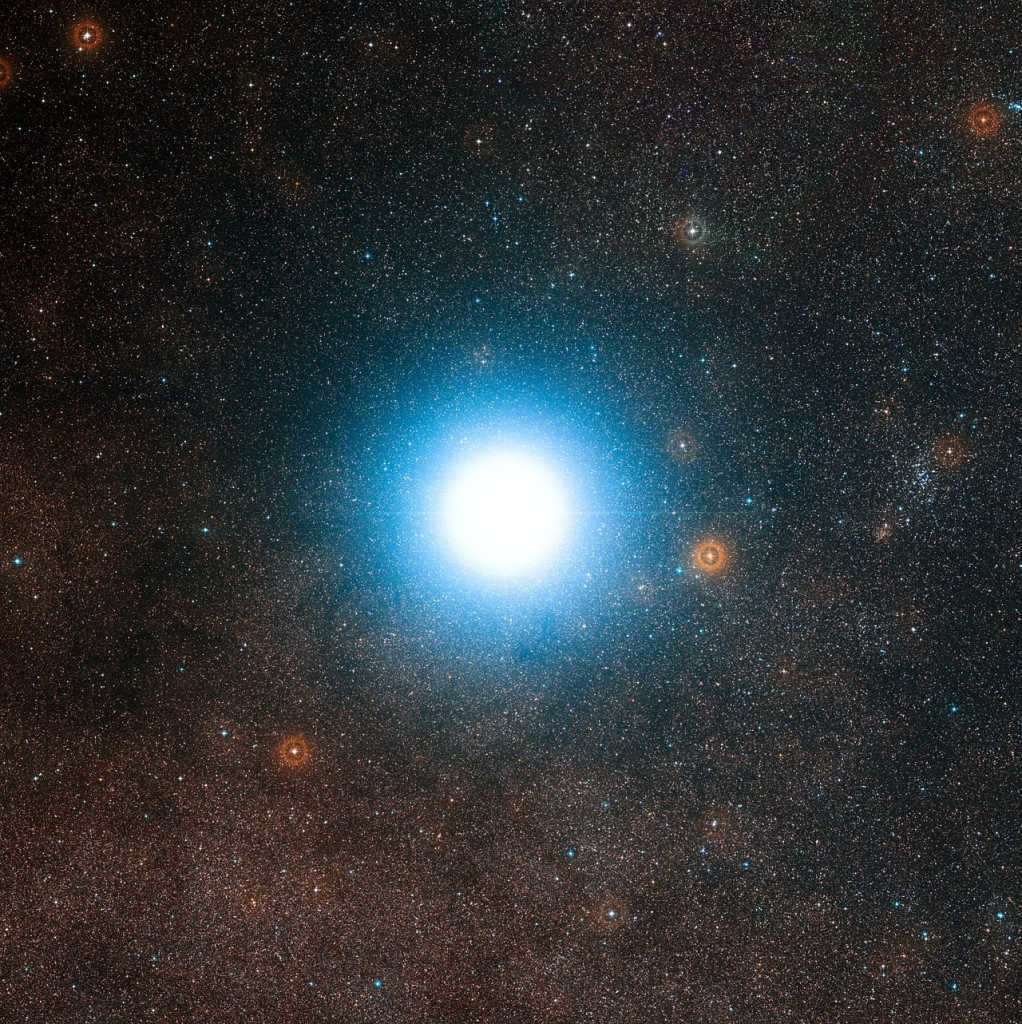
The two other parts of the system, Alpha Centauri A and Alpha Centauri B, have a close interaction with each other. When viewed from Earth, they appear as a single star. The distance to this system is 4.36 light years. These objects belong to spectral classes G and K, which are yellow and orange dwarfs. They have similar characteristics and temperature as the Sun, but they are older, with an age of 6 billion years. The Centauri A component is larger than its neighbor, with a mass of 1.1 and a diameter of 1.2 times that of the Sun. Centauri B has values of 0.9 and 0.86 for its mass and diameter, respectively. The rotation of these stars occurs along an elliptical orbit, with an inclination angle of 79.2 degrees. The period of their rotation is 79.9 years.
Alpha Centauri Exoplanets
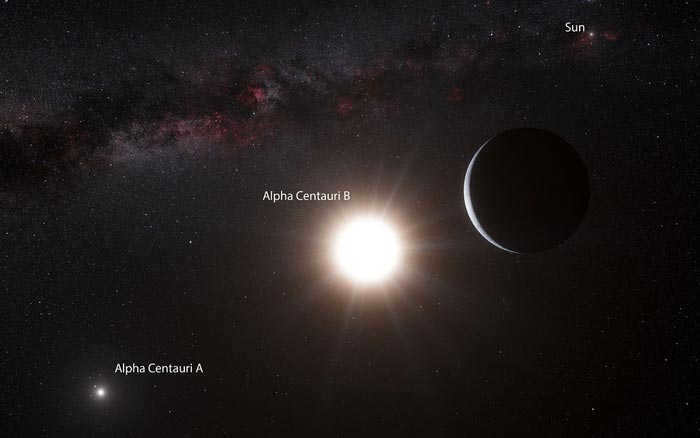
Additional research and computer simulation offer optimism for the existence of a second, larger, and more distant planet near Alpha Centauri B, with a rotational cycle of 20.4 days. Theoretical calculations suggest that the influence of Centauri A would occur approximately once every 70 years. If this planet has oceans, its barren exterior would be significantly more susceptible to such influences.
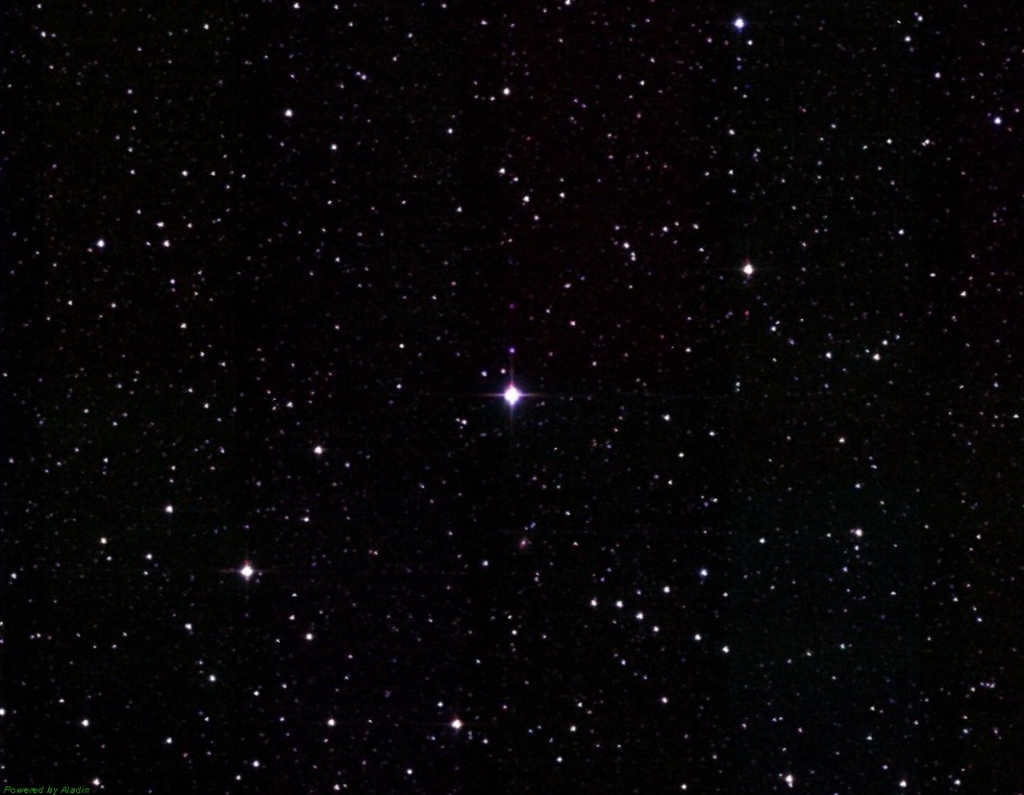
An M-class star known as Barnard’s star was discovered by E. Barnard in 1916 and named after him. This red dwarf is located in the Serpens constellation along the celestial equator and is approximately 5.96 light-years away from Earth. Despite being much smaller than our Sun, with only 0.17 times its mass and diameter, Barnard’s star is the fourth closest star to us, although it is not visible to the naked eye. This star, also known as “Flying Barnard,” is known for its rapid motion towards our Sun. In fact, it is projected to eventually surpass the distance between us and Proxima Centauri. Its remarkable speed allows it to cover a distance of 10.36 angular seconds per year.
Existence of planets
For many years, a team of researchers in California has been diligently working to detect any signs of planets in the vicinity of Barnard’s star. However, up until now, there has been a lack of conclusive evidence to support their existence.
Luman 16.
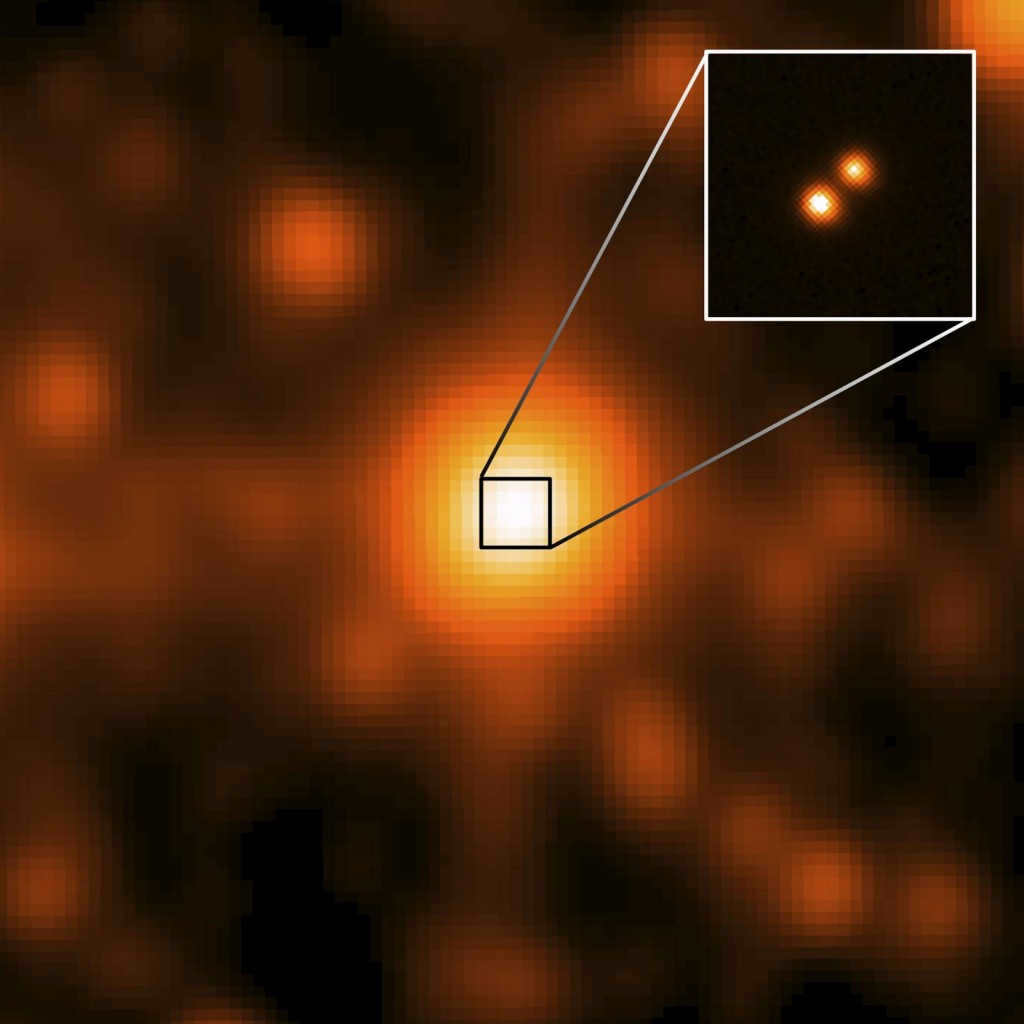
The constellation known as Sails, which can be seen in the Southern Hemisphere, has become a sanctuary for a pair of brown dwarfs that are the closest neighbors to the Sun. The distance to Luman 16 is approximately 6.59 light-years. Both components of this system are nearly identical, with a mass ranging from 0.4 to 0.5 times that of the Sun. The rotation period of this double star system is equivalent to two decades. No other objects in the vicinity of this binary system have been observed.
If a spacecraft from Earth were to embark on a journey to our nearest neighbor, Proxima Centauri, it would take approximately 70,000 years to reach its destination.
Out of the stars in our vicinity, only three are considered as first magnitude luminaries: Sirius, Alpha Centauri, and Procyon. Additionally, the nearest star to Earth is classified as a red dwarf.
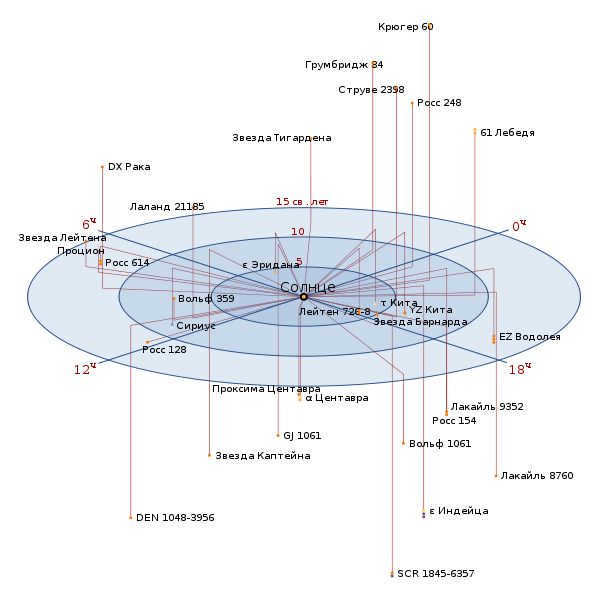
Among the hundred million stars in the Milky Way galaxy, the Sun is considered the fourth largest. It falls into the category of yellow dwarfs based on its spectral classification and is estimated to be around 4.5 billion years old. Currently, the Sun is in the middle stage of its life cycle. The closest star to our Sun is called Proxima Centauri and is located 4 light-years away. The distance between the Earth and the Sun measures 150 million kilometers, and it takes light approximately 8 minutes to travel this distance. The Sun is positioned 26 thousand light-years away from the center of the galaxy and rotates around the center once every 200 million years.
When the Sun reaches an age of approximately 7 billion years, it will undergo a transformation and evolve into a red giant. During this phase, the outer layers of the Sun will expand and extend beyond the orbit of Earth, possibly even reaching the orbit of Saturn. This expansion will cause a displacement of these planets, pushing them further away from the Sun. The Sun’s composition consists of 92% hydrogen and 7% helium, with a highly intricate and complex structure.
At the core of the Sun lies a central region with a radius of approximately 150,000 – 175,000 km, accounting for about 25% of the star’s total radius. Within this core, temperatures soar to a staggering 14,000,000 K. The core rotates at a significantly faster pace compared to the outer layers of the Sun. It is within this core that helium is synthesized through a reaction involving four protons, resulting in the release of a substantial amount of energy. This energy is then emitted from the Sun’s photosphere as both light and kinetic energy.
The Sun has a radiative transfer zone above its core, where temperatures range from 2-7 million K. This zone is then followed by a convective zone that extends about 200,000 kilometers in depth. Unlike the radiative transfer zone, the convective zone does not involve over-radiation or energy transfer. Instead, it consists of a mixing of plasma. The surface of this convective zone has a temperature of 5800 K. The visible surface of the Sun, known as the photosphere, is part of the Sun’s atmosphere and is accompanied by the chromosphere. The outermost layer of the Sun is the corona, from which the solar wind, a stream of ionized particles, emanates.
The Sun is the main source of life on Earth. It provides light and warmth, allowing plants to undergo photosynthesis and animals to thrive. The rotation of the planet on its axis gives us the opportunity to witness the beauty of dawn and dusk, as well as the twinkling stars in the night sky. Additionally, the Sun plays a crucial role in the production of vitamin D in the human body. Its solar wind, which can be seen as the mesmerizing northern lights, also affects the Earth’s atmosphere and can cause storms. Solar activity, including sunspots and solar flares, follows an approximate 11-year cycle, impacting various aspects of life on our planet.
Stars, among other celestial bodies, are truly remarkable creations. Astronomers have been studying them for centuries, yet they continue to make new discoveries and unravel their mysteries. These luminous objects in the sky captivate our imagination and remind us of the vastness and beauty of the universe.
“Neighboring Stars” in the Galaxy
The nearest star to Earth, and also the most well-known and pondered throughout the year, is undoubtedly the Sun. While it may not be the largest, it is the one upon which life on our planet depends. Numerous scientific articles have been penned about its size and power, giving people a general understanding of what it entails. However, the Sun has numerous “neighboring stars” that are situated in close proximity to Earth. Nearly all of these stars have been extensively studied by astronauts, with the exception of a few that are small and faint.
Here is a compilation of nearby stars:
- Centauri is a star system composed of three main components. All three parts are located within a 5 light-year radius from the Sun. The first component is Proxima Centauri, followed by Alpha Centauri A and Alpha Centauri B. Recent studies indicate that these stars have an estimated age of approximately 4,850,000 years. The temperatures on these stars range from 3,000 to 5,700 degrees Kelvin;
- Barnard’s star, also known as Barnard’s Flying Star, is a red dwarf that stands out due to its fast motion towards the Sun. It is expected to become the closest star to the Sun in the next 10,000 years, but will eventually move away again;
- Wolf 359 is another red dwarf star, with an apparent magnitude of 13.45;
- Laland 21185 is a red dwarf located more than 8 light-years away from the Sun. It has an apparent magnitude of 7.49 and a luminosity of 0.0052;
- Sirius is also similar to Centauri in that it is comprised of two parts: Sirius A and Sirius B. Sirius A, known as the Dog Star, is the brightest star after the Sun. Its luminosity is estimated to be between 17 and 23 times that of the Sun. Sirius B, also known as the Puppy, is a white dwarf that orbits around Sirius A.
These are just the top 5 stars that are in close proximity to Earth. Following them are the star Leiten or Kita (which is made up of two parts: A and B), Ross 154, Ross 248, Epsilon Eridanus, and Lutien 786-6. Each of these stars has unique characteristics such as weight, luminosity, temperature, and size. However, they all fall into the category of being the “nearest star to Earth”, making them of great interest not only to astronauts, but also to those who admire the beauty of the night sky.
The Sun is the nearest star to our planet. It is the most visible object in the sky, outshining all others. During nighttime, a multitude of celestial bodies can be observed, though it is impossible to determine their exact count. There is a compilation of celestial objects situated at a distance of 17 light years. Astronomers have compiled a list of 57 such objects, but for the purpose of this analysis, let us focus on only eight.
Objects in Close Proximity
Which celestial bodies are situated closer to the Earth? The following list includes some notable examples:
- The Sun.
- Alpha Centauri.
- Barnard’s dwarf.
- Luhman 16.
- W. 0855-0714.
- Wolf 359.
- Laland 21185.
- Sirius.
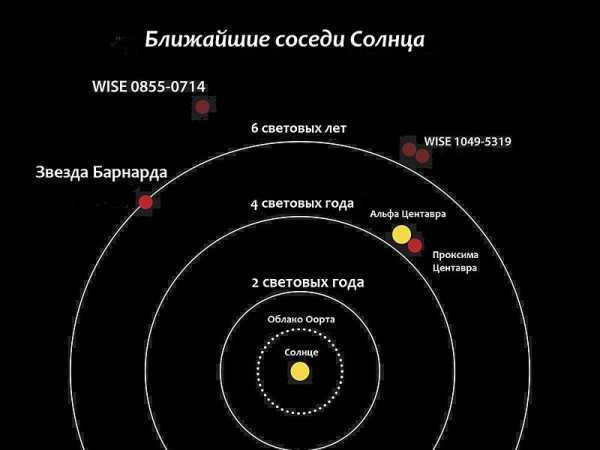
The immediate vicinity of the Sun.
The Sun
As the closest star to Earth, the Sun has a diameter of 1.391 million kilometers and comprises approximately 98% of the mass of the solar system. The distance between the Sun and our planet varies depending on its position, but on average it is about 149,600,000 km. Light from the Sun travels quickly, taking only 8 minutes and 19 seconds to reach Earth.
The nearest stars to our Solar System are Alpha Centauri. Alpha Centauri is not alone, as it is actually a binary star system, consisting of two stars orbiting around a common center of gravity. It takes approximately 80 years for the two stars to complete one orbit. The stars in the Alpha Centauri system are classified as Class A and Class B. Class A Alpha is brighter than our Sun, while Class B is dimmer. In addition to these two stars, there is a third member in the Alpha Centauri system called Proxima.
So, what is the closest star to Earth? It is actually Proxima, which is a member of the Alpha Centauri system. Proxima is located at a distance of 4.24 light-years from us.
Leader’s characterization
What is the nearest star to Earth? Proxima has held the title of being the closest star to our planet for the past 32,000 years. It will maintain its position for another 33,000 years. Over time, it will gradually reduce its distance to 3.11 light-years. However, this won’t occur until 26,700 light-years from now.
Proxima possesses distinct characteristics. It is a red dwarf star and falls under the spectral class. Its radius is less than 0.1 times that of the Sun. It doesn’t have high temperatures and doesn’t emit a significant amount of energy, making it invisible without special instruments. It was first observed in the 20th century. Its visibility is enhanced by the periodic flares it experiences, which are quite active. It is situated 0.21 light-years away from the Alpha Centauri system, leading to ongoing debates about whether it is in orbit around it.
Barnard
One of the closest celestial bodies to our planet is Barnard’s star. It is classified as a red dwarf and is part of the Serpens constellation. This dwarf star has a very low brightness and is not easily visible to the naked eye.
It was first documented in 1916 by the astronomer E.E. Barnard, after whom it was named. Barnard’s star is relatively small, with a mass that is less than that of the Sun (approximately 0.17 times its diameter). What sets Barnard’s star apart is its remarkable speed. Scientists predict that in the near future, this star will actually be closer to Earth than Proxima Centauri, the current closest star to our solar system. Barnard’s star has an annual proper motion of 10.36 arc seconds, which is considered to be a record-breaking speed for a star.
Luman 16 – The Closest Star to the Sun
Luman 16 is a binary star system consisting of two dwarf stars located in the Sail system of the Southern Hemisphere. It holds the distinction of being the nearest star to our Sun, with a distance of approximately 6.59 light years. Despite its proximity, Luman 16 is often overshadowed by its more illustrious neighbor, the Sun.
Both stars in the Luman 16 system are nearly identical, sharing a mass of 0.4 times that of our Sun. They have been in orbit around each other for the past 20 years, forming a stable binary system. Despite extensive observations, no other celestial bodies have been discovered in their vicinity.
WISE 0855-0714.
WISE 0855-0714 is the designation given to a celestial object that is believed to be a brown dwarf or possibly an orphan planet. It is located in the constellation Hydra and is estimated to be at a distance of 7.27 light years from Earth. This particular space object is notable for being the coldest known object of its kind. Its discovery was made in 2013 by the WISE 0855-0714 mission utilizing a space telescope.
Wolf 359, except for Alpha Centauri, is the nearest star to the Sun. This star is located in the Leo constellation. It is a solitary star and is positioned 7.80 light-years away from the Solar System, making it one of the closest stars to our system.
Wolf 359 is classified as a dwarf star and has a mass ranging from 0.09 to 0.13 times that of the Sun. Its radius is estimated to be between 0.16 and 0.19 times that of the Sun. In terms of brightness, it is fainter than Proxima, another nearby star. Wolf 359 was first discovered in 1918 through astrophotography and was named after its discoverer. Interestingly, the closest known object to our Solar System is Ross 128, which is located 3.79 light-years away.
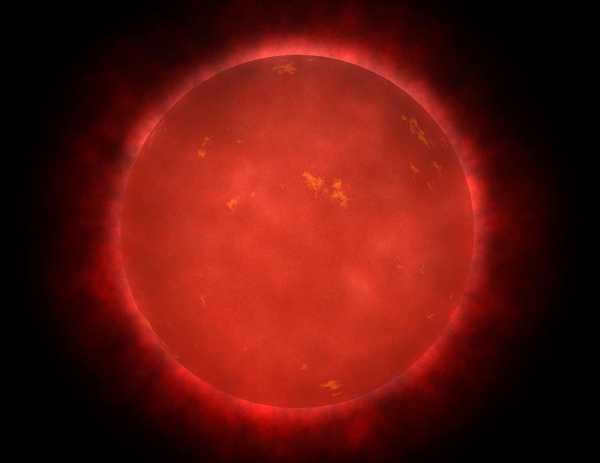
Laland 21185 – The Closest Star to Earth
Laland 21185 is classified as a red dwarf, specifically of the M2V spectral class. With a temperature of 3,400 K, it is much cooler than our Sun. In terms of size, Laland 21185 is significantly smaller than the Sun, with both its mass and diameter being less than half of our star’s. Despite its smaller size, Laland 21185 emits only 2% of the luminosity of the Sun, making it much dimmer. What’s interesting about this star is its peculiar motion – it moves in a perpendicular direction relative to the plane of the Galaxy, with a velocity of 47 km/s.
Laland 21185 is estimated to be around 100,000 million years old, while our Sun has an age of 4,600 million years. This makes Laland 21185 one of the oldest objects in the universe, with a history that predates our own solar system by a vast amount of time.
Sirius
A brilliant celestial object. From our vantage point on Earth, Sirius is situated approximately 8.60 light years away. It resides within the constellation known as Canis Major, or the Big Dog. Over time, Sirius undergoes a slow and steady increase in luminosity. This particular phase will persist for an extensive duration of 60,000 years. It will retain its status as the brightest star in the sky for another 210,000 years.
With a magnitude of -1.46, Sirius is twice the size of Canopus, a star located within the constellation Carina. Interestingly, despite being slightly less luminous than Rigel and Canopus, Sirius may not appear as such upon initial observation due to their greater distance from us.
At first glance, Sirius may appear to be a solitary star, but in actuality, it is a binary star system. It consists of the white star known as Sirius A, and the diminutive Sirius B, which is a dwarf star.
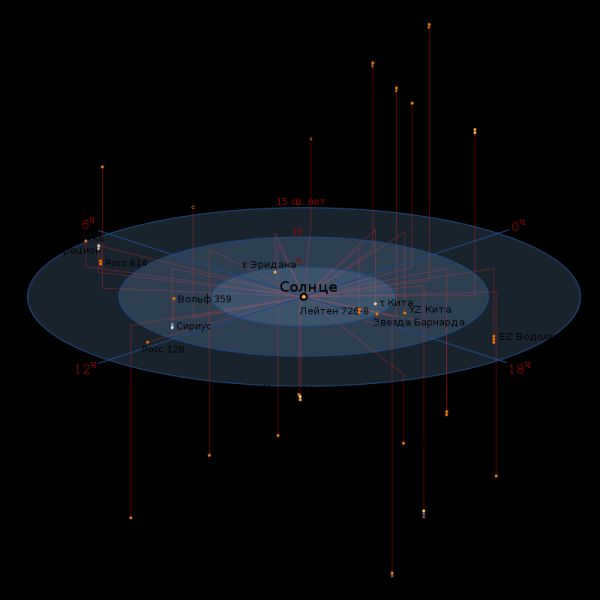
Determining the distance between our planet and the stars.
Parallax is utilized to ascertain the distance between our planet and the stars. The procedure is as follows: extend your arm and place your finger in front of an object that is slightly further away. Close one eye, then the other. The object appears to shift its position: this is known as parallax.
In order to calculate the distance to the star, it is necessary to position the Earth on one of its orbits during the summer season. Upon completing the calculation, it is required to wait for six months until the planet is on the opposite side, and then take another measurement. Next, compare the angle to the previous one. This principle is applicable to any celestial object that is situated at a distance of 100 light years.
There are 45 celestial bodies located at a distance of 17 light years. The Galaxy contains approximately 200 billion of these bodies, but it is impossible to accurately count all of them. Some may go undetected due to their faintness.
Nonetheless, scientists regularly search for planets within the systems of nearby stars. They specifically focus on dwarf stars, including yellow and red dwarfs. To detect these planets, scientists use spectrographs, which are special instruments mounted on high-powered telescopes that measure the radial velocity of celestial objects.
"Barnard’s star is notorious among astronomers due to the past discovery of planets in its orbit, although a re-evaluation of the data revealed calculation errors. However, we can now confidently state, with 99 percent certainty, that there is at least one planet out there!" – Guillem Anglada Eskude, a participant in the study from Queen Mary University in London (UK), declared.
An artist’s representation of a super-Earth near Barnard’s star. Credit: ESO/M. Kornmesser
The identification of the exoplanet was made possible through the collaborative efforts of over 60 scientists from various countries, working together on the Red Dots and CARMENES projects.
Swiftest celestial body in the heavens
Barnard’s star can be found in the equatorial constellation of Serpentine, and is visible across Russia with the exception of the northern regions. It holds the distinction of being the fourth most distant star from the Sun, as well as the nearest solitary luminary. In 1916, the renowned American astronomer Edward Emerson Barnard made the groundbreaking discovery of this star and it was subsequently named in his honor. In the late 1960s, another American astronomer by the name of Peter van de Kamp put forth the theory that there were three gas giants in the star’s system; however, his calculations have since been proven to be erroneous.
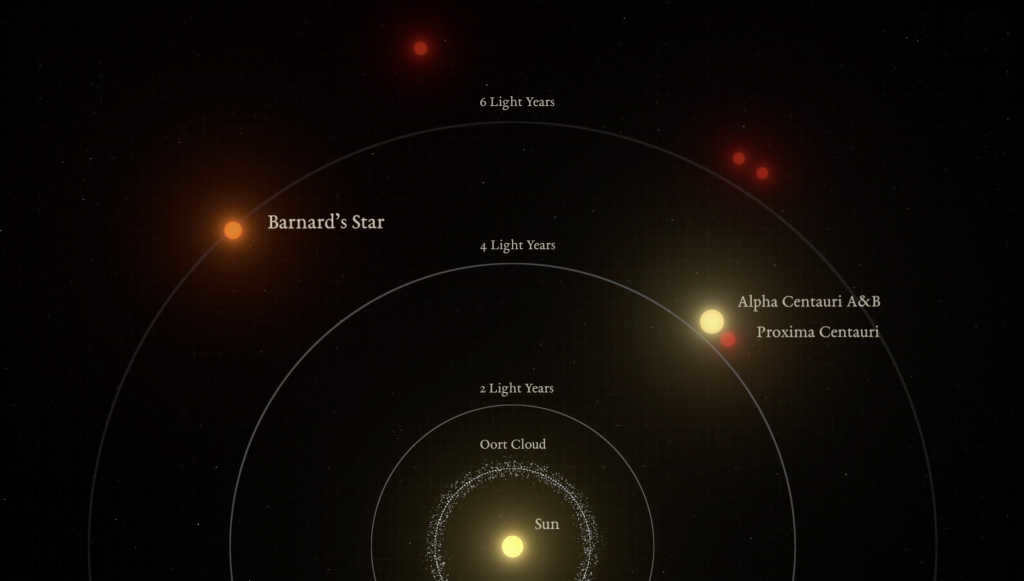
The Sun and Barnard’s star are separated by a considerable distance. The red dwarf, Barnard’s star, is estimated to be between 7-10 billion years old and is characterized by its cold and old nature. In terms of both mass and radius, Barnard’s star is approximately six times smaller than our Sun. Known for its impressive speed, it is often referred to as the “flying” or “fugitive” star. Among all celestial bodies, Barnard’s star has the fastest angular velocity. Over a period of 174 Earth years, this red dwarf shifts in the sky by half a degree, which is equivalent to the full disk of the Moon. Additionally, the star’s total speed relative to the Sun measures at about 500,000 kilometers per hour.
Monitoring Barnard’s Star for Two Decades
For the past twenty years, astronomers have been diligently searching for exoplanets orbiting Barnard’s star. However, their efforts have been in vain until now. The breakthrough finally came when they combined data from various high-precision instruments installed on telescopes across the globe.
“By merging archival data collected by other researchers with recent overlapping measurements of Barnard’s star taken using different equipment, we were able to make this groundbreaking discovery of an extrasolar planet,” said Guillem Anglada Eskude.
Astronomers employed the Doppler effect in order to locate the exoplanet. The essential concept of this phenomenon is as follows: when a massive object orbits a star, the star experiences a slight shift due to the gravitational forces at play. As the star moves away from Earth, its spectrum undergoes a red shift, signifying a small increase in the wavelengths present. Conversely, when the star moves closer to Earth, the wavelengths of its radiation shift towards the shorter, blue end of the spectrum.
“Over a span of twenty years, we made use of observations collected from various instruments, making this one of the most extensive and enduring datasets ever utilized for precise radial velocity measurements. Consequently, we acquired a substantial volume of data – a total of 771 measurements,” stated Ignacius Ribas, the primary author of the research conducted at the Institute for Space Research of Catalonia.
Frigid super-Earth and the potential for life
Discovered as Barnard’s star b (also known as Barnard’s star b or GJ 699 b), this recently found planet holds the distinction of being the second most distant from Earth. Preliminary data suggests that it falls into the category of “super-Earths”. With a minimum mass of 3.2 times that of our planet, a year on this exoplanet is equivalent to 233 Earth days.
Due to the relatively dim nature of its host star, Barnard’s b receives a mere 2 percent of the solar energy that Earth receives from the Sun.
Despite being relatively close to its host star, approximately 0.4 astronomical units away, the exoplanet is situated in close proximity to the snow line—a demarcation point where volatile substances like water vapor can transform into ice. Within this frozen and dim realm, temperatures likely hover around -170 degrees Celsius. Such harsh conditions do not provide a conducive environment for life as we currently understand it.
Additional research
“To eliminate any potential misconceptions, we will continue to observe this rapidly moving star and rule out any possible natural fluctuations in its brightness that could be mistaken for the presence of a planet,” says Ignacius Ribas.
Further observations are already underway at various observatories to increase confidence in the findings. Furthermore, the Barnard star system is an ideal candidate for study with the next generation of telescopes, specifically designed to directly capture images of exoplanets, such as NASA’s Wide Field Infrared Survey Telescope (WFIRST), set to be launched in 2024.
If Barnard’s star b is successfully captured in an image, it will provide valuable data about its characteristics and enhance our knowledge of the types of planets that form around red dwarfs.
Explanation:
Proxima Centauri is, in fact, the smallest of three stars that are gravitationally bound together.
The two larger stars, collectively known as Alpha Centauri, are tightly bound together as a binary star system; each of these stars has a mass similar to that of our Sun.
Proxima Centauri, which is a less massive type of star called a red dwarf, is located some distance away from the Alpha Centauri pair and orbits around them like a planet. However, Proxima Centauri is a star with its own planets.
For more information on Proxima Centauri, please refer to Proxima Centauri.
What is the most suitable object to be identified by a periodic change in the Doppler shift in the spectrum of a star, accompanied by a decrease in the star’s light intensity?

An orbiting exoplanet can be effectively identified by a periodic Doppler shift in the spectrum of a star along with a drop in the star’s light intensity. This kind of signal is often detected by the Kepler space telescope, which is specifically designed to search for such signals. The telescope is directed towards the Orion arm of the Milky Way, where it analyzes the light curve of individual stars to find evidence of exoplanets. When a planet passes in front of a star, it causes a decrease in the star’s light. By accurately measuring the extent of this dimming, scientists can determine the size of the planet. The timing between these light dips provides information about the planet’s orbital period. Detecting these light dips requires extremely precise measurements because the magnitude of the dimming is often very small.
What is the radius of a star that is 100 times larger than our Sun?

Here’s how we can calculate the radius of a star that is 100 times larger than our Sun. Let’s use some fictional values to gain some insight into this matter. Let’s assume that the surface temperature of our Sun is 10, and the surface temperature of the larger star, a red giant that has formed after leaving the main sequence, is 0.2. Additionally, let’s say that the radius of our Sun is 10, and the radius of the red giant is 1000 (100 times larger).
We can use the equation L = σAT^4, where σ is the Stefan-Boltzmann constant (which is approximately 5.67 times 10^-8). However, in this case, we can ignore the constant since we are only interested in the ratio.
